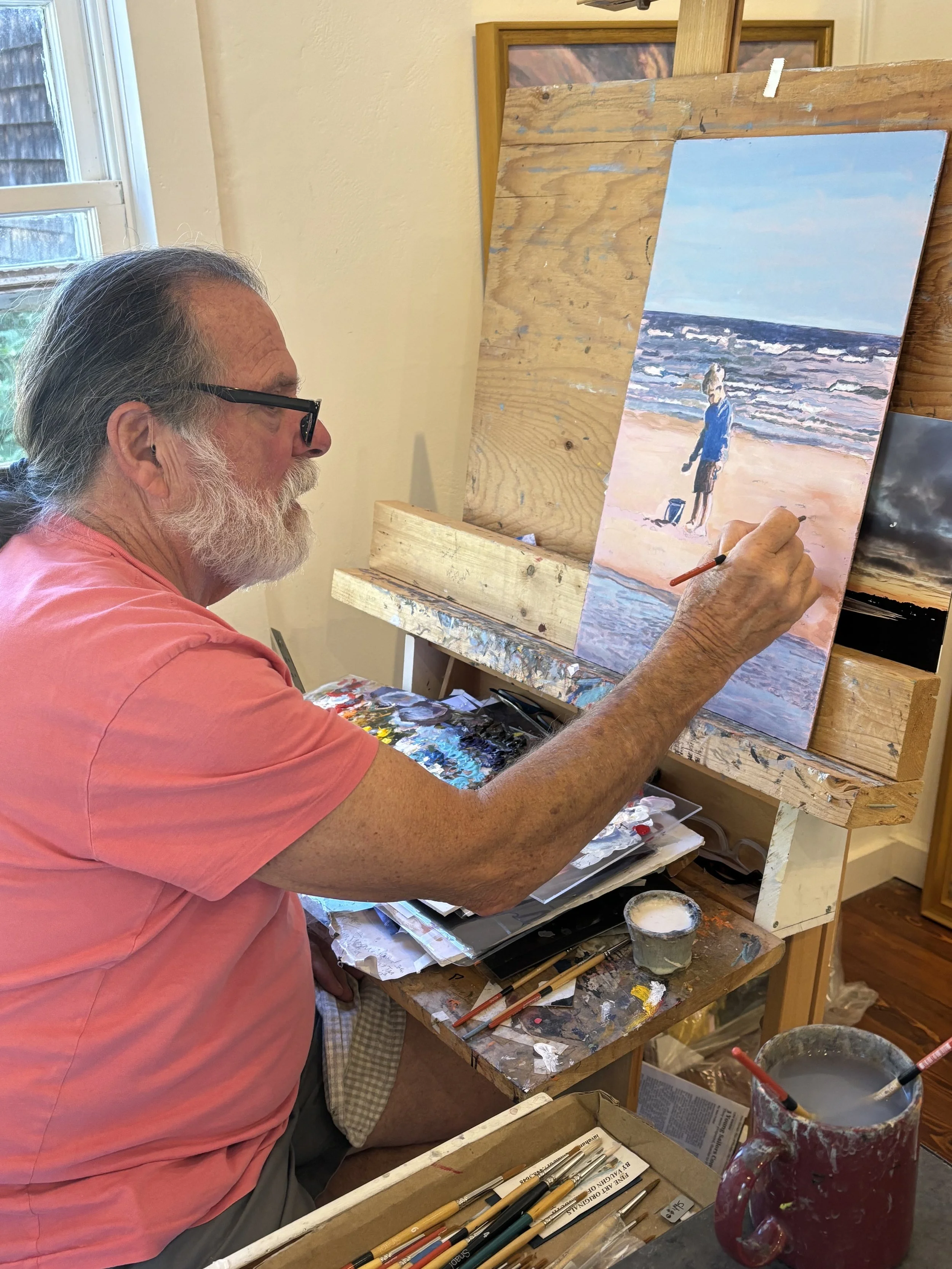Washing Ashore in Wellfleet
Paul Suggs: Artist, Oysterman and Font of Olympic Gold
Paul Suggs is, as born-and-bred Wellfleetians say, “a washashore”. A former oysterman, he doesn’t pick, grow or sell oysters any more. And yet few people today are more exemplary of the town’s shellfishing heritage than he.
Underlying the romantic image of shellfishing is the reality that oystering historically has demanded occupational diversity of its practitioners. That Suggs has been able to find success in multiple professions is central to understanding why Suggs is so admired in the local community. Besides his early career in oystering -- as both a shellfish harvester and retailer -- he is a successful artist, runs a successful house-painting business, and owns with his wife Ann Suggs a successful art gallery, The Works, on East Commercial Street. He is also a former winner at the Wellfleet OysterFest’s now-famous Shuck Off Championship.
As with many Wellfleet washashores over the years, serendipity played a role in his introduction to the town. Originally from Connecticut, Suggs was enrolled at the School of the Visual Arts in New York City, where he met a fellow artist and potter whose cousin invited the couple to visit her in Wellfleet. Like many artists before them, they were awed by the natural beauty and art-embracing spirit of the town. It only took them a month to pack their bags and move to Wellfleet. They immediately opened a gallery, and began looking for ways to support themselves. He met Joe Francis, one of Wellfleet’s leading oystermen (and among its most noted rascals) who had a seven-acre grant on Egg Island. Joe invited Suggs to work for him. In the early 1970s oyster farming in Wellfleet was still in its infancy. Oystering in those days amounted to shoveling tons of oyster seed from the mouth of the Herring Cove to dump on the grant, spending long days raking and working the beds. Oystering also involved harvesting large, oddly-shaped “banana” oysters from Chipman’s Cove, the wide basin in front of the Town Pier, and shucking them for their meat. Long winter months spent shucking those oysters led to honing the skills that ultimately led to his Shuck Off crown.
After a few years, Suggs made two decisions that would end his oystering career while at the same time cementing his prominence in the shellfishing industry. “I thought oystering was a dying industry,” he says with a laugh. “What did I know?” But he also correctly realized that selling oysters was a lot more profitable than harvesting and shucking them. In 1976 he formed the Mud Hake Oyster Company. It was the summer of the Tall Ships Festival in Boston, and he decided to set up a raw bar behind the new Boston Aquarium, where the festival bands were scheduled to play. “We dressed up like pirates,” he said, “and we also bought some huge lobsters and started selling raffle tickets for them.” The raw bar was a big hit, though the raffle venture went badly astray when the lobsters were stolen halfway through the festival.
Paul Sugg’s painting “The Oysterman” showing at The Works Gallery
“I was always looking to promote Wellfleet oysters,” he said, explaining why he later opened up several successful raw bars in Hyannis and then, in 1980, decided to take a gamble selling oysters at yet another big mainstream event, the Lake Placid Winter Olympics. He filled his van with as many oysters and clams as he could get his hands on, and headed west to New York State. There, his financial success at the Olympics was dramatically eclipsed by the celebrity he earned for providing oysters to a bunch of college men, amateur hockey players on the USA Olympic Hockey Team. Oyster lovers, many of whom who attended Boston-area colleges and universities, they were part of the team that will forever be remembered for their “Miracle On Ice”, stunning the world by beating the highly favored Russian Red Army squad.
If there is any one symbol for Sugg’s indelible place in the Wellfleet shellfishing community it is his presence in every Fourth of July Parade. Dressed in the sou’wester attire of a New England fisherman, Paul pushes a giant soft-shell clam, which at his command squirts a long stream of water from it neck into the crowd. The clam, which Sugg’s old his old boss Joe Francis pushed in the parade every year until his death in 1993. Francis’ famous squirter clam is Suggs’ paean to the cultural and economic importance of shellfishing and to Francis’ ineffable spirit. He says he will continue to do so until either his stepson and grandson, both active in the oyster industry, are ready to pick up the mantle. “It’s good to see them carrying on the legacy of the Wellfleet oyster,” he says, a proud smile on his face. “That’s pretty awesome.”


